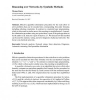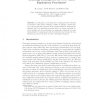1713 search results - page 19 / 343 » Analysis of Procedure Splitability |
AAECC
1999
Springer
13 years 8 months ago
1999
Springer
Effective quantifier elimination procedures for the reals allow to solve problems that can be encoded into corresponding first-order formulas including ordering constraints. In con...
POPL
2004
ACM
14 years 2 months ago
2004
ACM
The ability to summarize procedures is fundamental to building scalable interprocedural analyses. For sequential programs, procedure summarization is well-understood and used rout...
NIPS
2007
13 years 10 months ago
2007
Traditional analysis methods for single-trial classification of electroencephalography (EEG) focus on two types of paradigms: phase locked methods, in which the amplitude of the ...
IBPRIA
2003
Springer
14 years 2 months ago
2003
Springer
In this paper, a new approach to training set size reduction is presented. This scheme basically consists of defining a small number of prototypes that represent all the original ...
BMCBI
2005
13 years 9 months ago
2005
Background: Ambiguity is a problem in biosequence analysis that arises in various analysis tasks solved via dynamic programming, and in particular, in the modeling of families of ...


